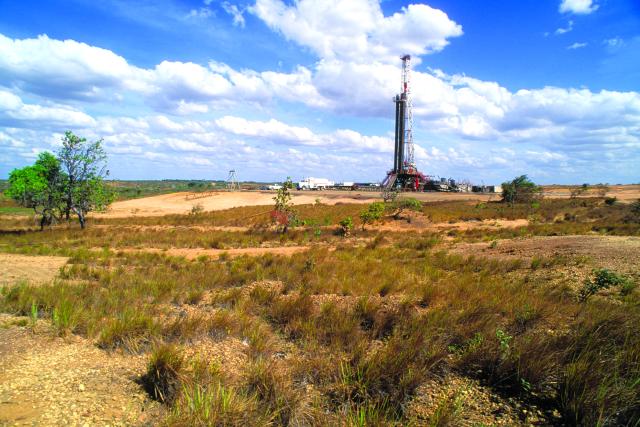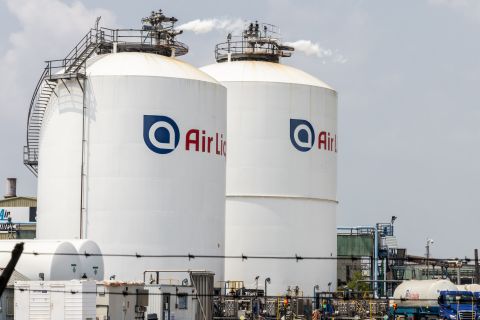
The SO/LO fluid system helped save the cost of an intermediate casing string in an operator’s Permian Basin slimhole exploration well. (Source: NOV)
Choosing the right drilling fluid for a chosen application necessitates a thorough understanding of formation characteristics and deep knowledge of the interaction between mud additives’ chemistry. Varying the composition of the drilling fluid for the parameters of each drilling scenario will enable improved rheological and physical properties, and with the optimal drilling fluid, an operator will be more effectively able to drill the longer, deeper, more complicated wells typical of shale.
The need for an advanced drilling fluid system adaptable to the challenging conditions of the Permian Basin was clear. Multiple issues in the basin must be analyzed and managed if operators are to achieve drilling objectives within the scope of project economics. Furthermore, the chemical composition of the well and the potential impact on the environment must also be considered. National Oilwell Varco’s (NOV) SO/LO system, an organophilic clay-free, nonaqueous drilling fluid system, is designed to help operators overcome these many challenges.
New fluids system
SO/LO is an oil-based mud (OBM) fluid system that is a new approach for controlling rheology and HP/HT properties in nonaqueous invert fluid systems. Designed to work as a lower solids system with the advantages of a high-performance water-based mud (WBM) system, SO/LO replaces traditional organophilic clays and mineral asphalts with engineered polymers. This provides predictable, fast-acting system treatments, improved equivalent circulating density and lower amounts of solids. The SO/LO system quickly builds gels when static, providing increased stability in the curve and lateral sections and improved cuttings-carrying capability over traditional OBM systems. Hydraulics performance is much like that of a polymer-based WBM system, including the ability to shear down quickly to achieve better flow and hydraulics properties. Properties are formed with chemical bonds rather than mechanical action, as in traditional invert systems, improving the stability and longevity of system properties and minimizing changes on trips.
Case histories
An operator in the Permian Basin had typically designed its wellbores for wells in the area with a four-string design. First, after setting surface casing, the Salado Formation, which is composed of significant salt beds, is drilled with brine and cased off. A second intermediate section is then drilled with freshwater through the Spraberry-Dean sandstone, which is below normal pressure. This section is horizontally and vertically fractured, and fluid weights must be kept as low as possible. After the Salado and Spraberry-Dean groups are cased off, the curve and lateral sections are drilled with a weighted fluid system to control unstable shale beds.
In a new exploration well, the operator wanted to eliminate the intermediate casing string. A slimhole design was proposed as a potential solution, but a freshwater fluid system could not be used due to unacceptable weight gains from chloride contamination in the Salado salt beds. Such weight gains would result in a loss of returns in the Spraberry-Dean group. The operator decided to use an OBM system to allow the low fluid weight required for the Spraberry-Dean and prevent
unacceptable fluid weight increases from the Salado salt bed. Problematically, the low bottomhole temperature at displacement, which was less than 38 C (100 F), and difficult winter condition at the surface would make getting a traditional OBM system up to optimal operating temperatures a challenge.
The operator selected the SO/LO system for its utility in wells requiring low fluid densities, with limited tolerance to density fluctuations, and low bottomhole temperatures. An 8.8-ppg to 9-ppg fluid weight was maintained during the well, and there were no lost returns or seepage. This allowed the operator to drill the interval from 731 m to 3,244 m (2,400 ft to 10,643 ft) true vertical depth (TVD) through the Salado, Spraberry-Dean and Wolfcamp formations without having to set casing. These formations included salt beds, carbonate sections and unstable illite shale beds. The well was logged without issue and temporarily plugged for future re-entry to drill the curve and lateral. The operator estimated a cost savings of $250,000 in casing, cementing and related expenses.
In another example, an operator in the Permian Basin needed to complete a wildcat exploration well crossing the Barnett and Woodford plays. Borehole stability was of primary concern due to the well crossing at least one fault, and there was a potential for tilted bedding planes. The well’s lateral was open for 105 days, numerous unplanned trips were required and, ultimately, two faults were crossed. The curve was landed at 4,288 m (14,068 ft) measured depth (MD) and 4,205 m (13,796 ft) TVD, and well total depth was reached at 5,603 m (18,384 ft) MD and 4,095 m (13,437 ft) TVD. The harsh conditions of the well dictated that the planned fluid weight be increased from 11 ppg to 15.5 ppg to maintain wellbore stability. Though the extreme weight increase was unexpected based on geological evaluations, the wellbore remained stable while drilling and on trips despite the adverse conditions.
At 110 C (230 F), the bottomhole temperature was one of the highest of any lateral in the Permian to date. Furthermore, the lateral was one of the deepest drilled to date. The operator overcame the challenges of wellbore stabilization and flow concerns with the SO/LO system, which met the operator’s requirements at the higher fluid weight in an unstable wellbore with higher bottomhole temperatures, and at total depth production casing was run to bottom without issue. The SO/LO system allowed the operator to build strong, yet fragile gel strengths, which served to protect the curve and lateral. Rheology control and the ability to handle the HP/HT concerns of the well were main objectives, and SO/LO was a clear enabler of the operator’s success in this instance.
Conclusion
Today’s drilling challenges will continue to demand fluid systems that can overcome the technological and economic demands of difficult wells. Despite some commodity price recovery since the fall-off in late 2018, the industry remains capital-constrained and eager to find new cost efficiencies, particularly with capex budgets slashed earlier this year. The SO/LO system from NOV provides operators with very competitive drilling fluid approval for expenditure by reducing the need for sweeps and cleanup cycles and greatly reducing time spent washing to bottom and on short trips. Additionally, the system is easy to learn and simple to run.
When determining the right solution to their challenges, a major part of an operator’s planning and decision-making should go into choosing the right drilling fluid system, and consistency is an important performance criterion. In several hundred wells, no laterals have been lost due to wellbore instability when using SO/LO, even in extended-reach applications exceeding 4.8 km (3 miles). Additionally, SO/LO can be used for frac invasions with oil-water ratios as low as 40:60.
Recommended Reading
TechnipFMC Eyes $30B in Subsea Orders by 2025
2024-02-23 - TechnipFMC is capitalizing on an industry shift in spending to offshore projects from land projects.
Air Products Sees $15B Hydrogen, Energy Transition Project Backlog
2024-02-07 - Pennsylvania-headquartered Air Products has eight hydrogen projects underway and is targeting an IRR of more than 10%.
Air Liquide Eyes More Investments as Backlog Grows to $4.8B
2024-02-22 - Air Liquide reported a net profit of €3.08 billion ($US3.33 billion) for 2023, up more than 11% compared to 2022.
Kimmeridge Fast Forwards on SilverBow with Takeover Bid
2024-03-13 - Investment firm Kimmeridge Energy Management, which first asked for additional SilverBow Resources board seats, has followed up with a buyout offer. A deal would make a nearly 1 Bcfe/d Eagle Ford pureplay.
M4E Lithium Closes Funding for Brazilian Lithium Exploration
2024-03-15 - M4E’s financing package includes an equity investment, a royalty purchase and an option for a strategic offtake agreement.





